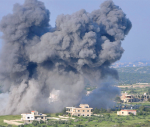You are here
A witness to Naksa
Jun 08,2017 - Last updated at Jun 08,2017
Ever since he told me about it a few years ago, I was unable to erase it from my memory. It had such an indelible effect that whenever we mark the setback of 1967 I vividly remember that evening.
It all started when I asked him about his opinion about a TV series that chronicles the Palestinian struggle.
He confessed that the protagonist of the series was based on his life, as the writer met him while writing the screenplay.
I was not surprised, as he was a brilliant Palestinian.
Then, we talked about the representation of the six-day war of 1967 in series.
That seemed to be the trigger for what ensued, for he bore witness to the war.
He was 10 years old then. On the last day of the war, his family, along with many others, was forced to leave their village because of the Israeli bombing.
His parents were carrying their “bundles”, a fixture of Palestinian refugeehood, one that Israelis keep reminding Palestinians of: “Take your bundles and leave,” as Israeli Foreign Minister Avigdor Lieberman put it.
It was an arduous journey. They were about to cross the King Hussein Bridge when an Israeli gunship bombed the bridge and created huge holes in it, making it impassable.
Before the bombing, being a curious boy, he noticed that there was a pregnant woman who was having difficulty moving along. For an innocent child, this was a mysterious scene.
After the bombing, his eyes looked for her. After a while, he was able to see her figure in the distance trudging along, bending every now and then to do something that was not clear to him due to the plumes of dust and smoke that pervaded the air.
He managed to make her face out a few seconds later. It was different: It was haggard and full of dust. But more noticeably, she was bleeding.
The blood was coming from her belly. It was a huge wound, more like a hole, which was probably caused by shrapnel.
His parents were pulling him along, but he could not resist looking back.
He was eager to know why the woman was bending constantly while she was on the bank of the Jordan River. It was a comment made by his father that cleared the picture up: The woman was applying mud to cover the gory hole in her belly and stop the bleeding.
It was mesmerising.
She then fell to the ground. He wanted to help her and tried to run towards her, but his father pulled him away, fearing that the Israeli jet flights would attack again, as the droning was still audible.
At the end of his narration, he told me: “I do not know what happened to the woman. In all probability, she died. But I was unable to efface that gory scene from my memory. It is part of me now, my history.”
It was a synecdochical moment for the narrator, as it represented a break, a rupture.
It was the end of Palestine for him: he would never go back. It was the end of his childhood: no more innocence. It was a moment of disunification.
On the other side of the bank, it represented the fulfilment of a myth. The Zionists were celebrating what they called the reunification of Jerusalem. It was a dream.
For the narrator, it could have been a nightmare, as it had all the components of a nightmare; it was a moment of severance between the mother and her child, between the human being and her body, between the land and its native inhabitants. But he did not yield to its tentacles.
For him, it was a beginning; the beginning of a successful career, for he would be a distinguished Palestinian.
It was a moment of reunification too, as this historical moment gave him the impetus to move ahead, to seek coherence, to fix the irreparable damage, to tell his story, and to replace the tragic history with a dream of going back to his town.
It was simply the beginning of sumood (steadfastness).
Deep down, his story made me believe again that endings sometimes make beginnings possible.
The writer, a Fulbright scholar, contributed this article to The Jordan Times.












